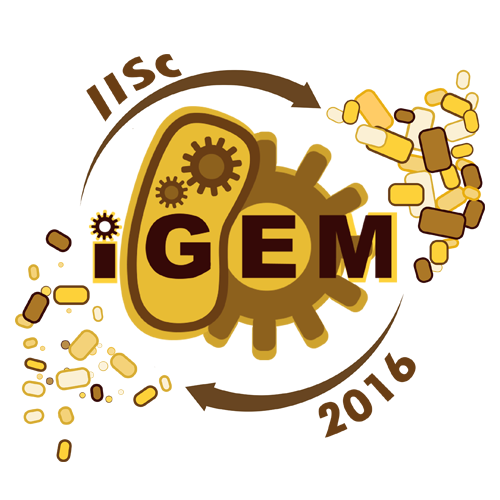(Prototype team page) |
Prabaha007 (Talk | contribs) |
||
| (35 intermediate revisions by 3 users not shown) | |||
| Line 1: | Line 1: | ||
| − | {{IISc_Bangalore}} | + | {{Template:IISc_Bangalore/hide}} |
| + | {{Template:IISc_Bangalore/bootstrap.css}} | ||
| + | {{Template:IISc_Bangalore/fontawesome.css}} | ||
| + | {{Template:IISc_Bangalore/style.css}} | ||
| + | {{Template:IISc_Bangalore/sidebar.css}} | ||
| + | {{Template:IISc_Bangalore/safety.css}} | ||
| + | {{Template:IISc_Bangalore/animate.css}} | ||
| + | {{Template:IISc_Bangalore/hover.css}} | ||
| + | {{Template:IISc Bagalore/collaborations.css}} | ||
| + | {{Template:IISc_Bangalore/accordian.css}} | ||
| + | {{Template:IISc_Bangalore/sidebar.js}} | ||
| + | {{Template:IISc_Bangalore/anijs.js}} | ||
| + | |||
<html> | <html> | ||
| + | <head> | ||
| + | <title>Team IISc iGem</title> | ||
| + | <link rel='stylesheet prefetch' href='http://netdna.bootstrapcdn.com/font-awesome/4.2.0/css/font-awesome.css'> | ||
| − | < | + | <link rel="stylesheet" href="http://anijs.github.io/lib/anicollection/anicollection.css" /> |
| − | + | ||
| − | + | ||
| + | <meta name="viewport" content="width=device-width, initial-scale=1"> | ||
| + | <link rel="stylesheet" href="https://maxcdn.bootstrapcdn.com/bootstrap/3.3.7/css/bootstrap.min.css"> | ||
| + | <script src="https://ajax.googleapis.com/ajax/libs/jquery/1.12.4/jquery.min.js"></script> | ||
| + | <script src="https://maxcdn.bootstrapcdn.com/bootstrap/3.3.7/js/bootstrap.min.js"></script> | ||
| − | < | + | <link href="css/bootstrap.css" rel="stylesheet" type="text/css" media="all"> |
| − | </ | + | <link rel="stylesheet" href="https://maxcdn.bootstrapcdn.com/bootstrap/3.3.7/css/bootstrap.min.css" integrity="sha384-BVYiiSIFeK1dGmJRAkycuHAHRg32OmUcww7on3RYdg4Va+PmSTsz/K68vbdEjh4u" crossorigin="anonymous"> |
| + | <script src="https://use.fontawesome.com/fce310c82d.js"></script> | ||
| + | <script src="js/jquery-1.11.0.min.js"></script> | ||
| + | <script type="text/javascript" src="js/bootstrap.js"></script> | ||
| + | <link href="css/style.css" rel="stylesheet" type="text/css" media="all"/> | ||
| + | <link rel="stylesheet" href="css/flexslider.css" type="text/css" media="screen" /> | ||
| + | <meta name="viewport" content="width=device-width, initial-scale=1"> | ||
| + | <meta http-equiv="Content-Type" content="text/html; charset=utf-8" /> | ||
| + | <script type="application/x-javascript"> addEventListener("load", function() { setTimeout(hideURLbar, 0); }, false); function hideURLbar(){ window.scrollTo(0,1); }> | ||
| + | </script> | ||
| + | <meta name="keywords" content="Team IISc igem" /> | ||
| + | <!--Google Fonts--> | ||
| + | <link href="css/font-awesome.min.css" rel="stylesheet" type="text/css" media="all" /> | ||
| + | <link href='//fonts.googleapis.com/css?family=Roboto:400,700' rel='stylesheet' type='text/css'> | ||
| + | <link href="https://fonts.googleapis.com/css?family=Bitter" rel="stylesheet"> | ||
| + | <link href="https://fonts.googleapis.com/css?family=Varela+Round" rel="stylesheet"> | ||
| + | <link href="https://fonts.googleapis.com/css?family=Roboto:300" rel="stylesheet"> | ||
| + | <link href="https://fonts.googleapis.com/css?family=Cormorant+Garamond:400,500" rel="stylesheet"> | ||
| + | <!--JS for animate--> | ||
| + | <link href="css/animate.css" rel="stylesheet" type="text/css" media="all"> | ||
| + | <!-- here are mine --> | ||
| + | <link rel="stylesheet" href="sidebar.css"> | ||
| + | <link rel="stylesheet" href="notebSafety.css"> | ||
| + | <link rel="stylesheet" href="hover.css" > | ||
| + | <script src="sidebar.js"></script> | ||
| + | </head> | ||
| + | <body> | ||
| + | <!--banner start here--> | ||
| + | <!-- <div class="banner"> | ||
| + | <div class="container"> --> | ||
| + | <nav class="navbar navbar-fixed-top text-center navbar-inverse"> | ||
| + | <div class="container-fluid"> | ||
| + | <div class="navbar-header"> | ||
| + | </div> | ||
| + | <div class="collapse navbar-collapse" id="myNavbar"> | ||
| + | <ul class="nav navbar-nav"> | ||
| + | <li class="active hvr-underline-from-left"><a href="https://2016.igem.org/Team:IISc_Bangalore">Home</a></li> | ||
| + | <li class="hvr-underline-from-left"><a href="https://2016.igem.org/Team:IISc_Bangalore/Team">Team</a></li> | ||
| − | < | + | <li class="dropdown"><a class="dropdown-toggle" data-toggle="dropdown" href="#">Project </a> |
| − | < | + | <ul class="dropdown-menu"> |
| − | < | + | <li><a href="https://2016.igem.org/Team:IISc_Bangalore/Description">Description</a></li> |
| + | <li><a href="https://2016.igem.org/Team:IISc_Bangalore/Experiments">Experiments</a></li> | ||
| + | <li><a href="https://2016.igem.org/Team:IISc_Bangalore/Results">Results</a></li> | ||
| + | <li><a href="https://2016.igem.org/Team:IISc_Bangalore/Notebook">Notebook</a></li> | ||
| + | <li><a href="https://2016.igem.org/Team:IISc_Bangalore/Safety">Safety</a></li> | ||
| + | </ul> | ||
| + | </li> | ||
| − | + | <li class="hvr-underline-from-left"><a href="https://2016.igem.org/Team:IISc_Bangalore/Parts">Parts</a></li> | |
| − | + | ||
| − | + | ||
| − | + | ||
| − | + | ||
| − | <li | + | |
| − | + | ||
| − | + | ||
| + | <li class="hvr-underline-from-left"><a href="https://2016.igem.org/Team:IISc_Bangalore/Collaborations">Collaborations</a></li> | ||
| + | <li class="hvr-underline-from-left"><a href="https://2016.igem.org/Team:IISc_Bangalore/Attributions">Attributions</a></li> | ||
| + | <li class="hvr-underline-from-left"><a href="https://2016.igem.org/Team:IISc_Bangalore/Human_Practices">Human Practices</a></li> | ||
| + | <li class="hvr-underline-from-left"><a href="https://2016.igem.org/Team:IISc_Bangalore/InterLab">InterLab</a></li> | ||
| + | <li class="dropdown"><a class="dropdown-toggle" data-toggle="dropdown" href="#">Special Prizes</a> | ||
| + | <ul class="dropdown-menu"> | ||
| + | <li><a href="https://2016.igem.org/Team:IISc_Bangalore/Integrated_Practices">Integrated Human Practices</a></li> | ||
| + | <li><a href="https://2016.igem.org/Team:IISc_Bangalore/Engagement">Education and Public Engagement</a></li> | ||
| + | <li><a href="https://2016.igem.org/Team:IISc_Bangalore/Model">Model</a></li> | ||
| + | <li><a href="https://2016.igem.org/Team:IISc_Bangalore/Measurement">Measurement</a></li> | ||
| + | <li><a href="https://2016.igem.org/Team:IISc_Bangalore/Entrepreneurship">Entrepreneurship</a></li> | ||
| + | <li><a href="https://2016.igem.org/Team:IISc_Bangalore/Design">Applied Design</a></li> | ||
| + | </ul> | ||
| + | </li> | ||
| + | </ul> | ||
| + | </div> | ||
| + | |||
| + | </div> | ||
| + | </nav> | ||
| + | |||
| + | |||
| + | <div class="banner-main"> | ||
| + | |||
| + | <section class="slider"> | ||
| + | <div class="flexslider"> | ||
| + | <span class="attri hvr-bounce-to-right ">Model</html> | ||
| + | [[File:IgemIISc.jpg|100px]] | ||
| + | <html></span> | ||
| + | |||
| + | </div> | ||
| + | </section> | ||
| + | |||
| + | </div> | ||
| + | |||
| + | <!--FlexSlider--> | ||
| + | <link rel="stylesheet" href="css/flexslider.css" type="text/css" media="screen" /> | ||
| + | <script defer src="js/jquery.flexslider.js"></script> | ||
| + | <script type="text/javascript"> | ||
| + | $(function(){ | ||
| + | SyntaxHighlighter.all(); | ||
| + | }); | ||
| + | $(window).load(function(){ | ||
| + | $('.flexslider').flexslider({ | ||
| + | animation: "slide", | ||
| + | start: function(slider){ | ||
| + | $('body').removeClass('loading'); | ||
| + | } | ||
| + | }); | ||
| + | }); | ||
| + | </script> | ||
</div> | </div> | ||
| + | </div> | ||
| + | <!--banner end here--> | ||
| + | <!--welcome--> | ||
| + | |||
| + | <!--welcome--> | ||
| + | |||
| + | |||
| + | <!--content-middle--> | ||
| + | <div class="content-middle wthree"> | ||
| + | <div class="" id="refer2"> | ||
| + | <div class="mid-content wow fadeInRight animated" data-wow-delay=".5s"> | ||
| + | <h3>Quorum sensing</h3> | ||
| + | <p>Null model</p> | ||
| + | </div> | ||
| + | <div class="row"> | ||
| + | <div class="refer col-md-6"> | ||
| + | |||
| + | <p>A model was constructed to find out the optimal conditions for the production of the protein of interest, which is controlled by quorum sensing. It was assumed that the synthesis of autoinducer molecules is negligible before the log phase in the bacterial growth curve kicks in, and also that after protein protein production begins, the cells practically stop dividing. An expression was found for the optimal ratio of the threshold autoinducer concentration to the rate of autoinducer synthesis to maximize the synthesis of the recombinant protein.</p> <br> | ||
| + | <b class="sectionHeading">Assumptions</b> | ||
| + | <ul class="section"> | ||
| + | <li> The protein production starts in the log phase of bacterial growth.</li> | ||
| + | <li> The switch that stops the bacterial growth takes a small time $t_s$.</li> | ||
| + | <li> The amount of quorum sensing molecule (A) at time $t=0$ is $0$.</li> | ||
| + | </ul> | ||
| + | |||
| + | <b class="sectionHeading">Notations</b> | ||
| + | <ul class="section"> | ||
| + | <li> $A$ -- Amount of quorum sensing molecule</li> | ||
| + | <li> $A_t$ -- Threshold amount of quorum sensing molecule (Adjustable parameter, by changing affinity of quorum sensing molecule for the switch)</li> | ||
| + | <li> $n_i$ -- Initial number of bacteria in solution</li> | ||
| + | <li> $n_f$ -- Final number of bacteria in solution (at threshold)</li> | ||
| + | <li> $r$ -- Rate of production of quorum sensing molecule per bacteria (Adjustable by changing promoter)</li> | ||
| + | <li> $g$ -- Inverse of generation time</li> | ||
| + | </ul> | ||
| + | |||
| + | <b class="sectionHeading">Calculations</b><br> | ||
| + | <p class="section">Since the bacterial is in the log phase, the number of bacteria at time $t=t$, if the initial number of bacteria was $n_i$ is, | ||
| + | \begin{align*} | ||
| + | n = n_i2^{gt} | ||
| + | \end{align*} | ||
| + | So, the rate of production of the quorum sensing molecule, if the rate of production by each bacteria is $r$ is, | ||
| + | \begin{align*} | ||
| + | \frac{dA}{dt} = rn_i2^{gt} | ||
| + | \end{align*} | ||
| + | Now, if we solve it, | ||
| + | \begin{align*} | ||
| + | dA = rn_i2^{gt}dt | ||
| + | \end{align*} | ||
| + | Integrating, | ||
| + | \begin{gather*} | ||
| + | A = \frac{rn_i2^{gt}}{g}\\ | ||
| + | \Rightarrow A_t = \frac{rn_i2^{gt}}{g} = \frac{rn_f}{g}\\ | ||
| + | \Rightarrow n_f = \frac{A_tg}{r} | ||
| + | \end{gather*} | ||
| + | Now, expressing $n_f$ in terms of $n_i$, and taking the time to reach threshold is $t^*$, | ||
| + | \begin{gather*} | ||
| + | n_i2^{gt^*} = \frac{A_tg}{r}\\ | ||
| + | \Rightarrow t^* = \frac{1}{g}\log_{2}\frac{A_tg}{rn_i} | ||
| + | \end{gather*} | ||
| + | If we modify our equation slightly to incorporate the fact that production at $t=0$ is $0$, we get, | ||
| + | \begin{gather*} | ||
| + | A(t, n_i) = \frac{rn_i}{g} \left( 2^{gt}-1 \right)\\ | ||
| + | \Rightarrow t^* = \frac{1}{g}\log_{2}\left(\frac{A_tg}{rn_i}+1\right) | ||
| + | \end{gather*} | ||
| + | Considering the fact that the switch takes time $t_s$ to work, | ||
| + | \begin{align*} | ||
| + | A(t^*+t_s, n_i) &= \frac{rn_i}{g} \left( 2^{g(t^*+t_s)}-1 \right)\\ | ||
| + | &= \frac{rn_f2^{gt_s}}{g} - \frac{rn_i}{g} \text{ (because $n_f=n_i2^{gt^*}$)} | ||
| + | \end{align*} | ||
| + | The cell density after the switch turns on is $n_f'$. So, | ||
| + | \begin{align*} | ||
| + | n_f' &= n_i2g^{(t^*+t_s)}\\ | ||
| + | &= n_f2^{gt_s}\\ | ||
| + | &= \left(\frac{A_t g}{r} + n_i\right)2^{gt_s} | ||
| + | \end{align*} | ||
| + | To achieve initial density, $n_i$ again, the fraction to be removed is, | ||
| + | \begin{align*} | ||
| + | \frac{n_f'-n_i}{n_f'} &= \frac{\frac{A_tg}{r}}{\frac{A_tg}{r}+n_i} + \frac{n_i\left(2g^{t_s}-1\right)}{\left(\frac{A_tg}{r}+n_i\right)2^{gt_s}} | ||
| + | \end{align*} | ||
| + | Let us assume the cells secrete product for $t_p$ amount of time after the switch is turned on. The constraint on $t_p$ and $t^*$ is that their sum is a constant for a given amount of media, since it basically represents the nutrient content. So, $t_p = C - t^*$, where $C$ is the constant. Let us assume that the product is produced at a per-capita rate, $p$. So, total product is, | ||
| + | \begin{align*} | ||
| + | P = pt_pn_f' | ||
| + | \end{align*} | ||
| + | Product formed per unit total time (one cycle time) is, | ||
| + | \begin{align*} | ||
| + | B = \frac{P}{t^*+t_s+t_p} | ||
| + | \end{align*} | ||
| + | Assuming $t_s$ is a constant (given a robust switch), the denominator is a constant. Thus to maximize product formed per unit total time (one cycle time), we just maximize its numerator P. | ||
| + | \begin{align*} | ||
| + | P = p\left(\frac{A_t g}{r} + n_i\right)2^{gt_s}\left(C-\frac{1}{g}\log_{2}\left(\frac{A_tg}{rn_i}+1\right)\right) | ||
| + | \end{align*} | ||
| + | Defining $\frac{A_t}{r}=k$, (please note that $A_t$ and $r$ are adjustable) we can write $P$ in terms of $k$, and take its derivative with respect to $k$. | ||
| + | \begin{align*} | ||
| + | \frac{dP}{dk} = p2^{gt_s}\left(gC-\log_2\left(\frac{kg}{n_i}+1\right)-\frac{1}{\ln2}\right) | ||
| + | \end{align*} | ||
| + | When $B$ is maximum, $\frac{dP}{dk}=0$. Using this result, we derive the optimal $k$ (for highest $B$), | ||
| + | \begin{align*} | ||
| + | k^* = \left(2^{\left(gC-\frac{1}{\ln2}\right)}-1\right)\frac{n_i}{g} | ||
| + | \end{align*} | ||
| + | $k^*$ makes biological sense only if $gC>\frac{1}{\ln2}$, otherwise $k^*< 0$, but $gC$ is the number of generations of division and secretion which is expected to be much greater than $\sim 1.5$ (rough value of $\frac{1}{\ln2}$).<br><br> | ||
| + | At $k^*$, $\frac{dP}{dk}=0$, but this is insufficient to say that $k^*$ is a maxima of B (just a critical point is proved). However, since there is only one critical point, and $\frac{dP}{dk}$ at $k^*$, when $k^*>0$ is also positive, it implies that $B$ increases from $k=0$ and $k^*$ has to be a maxima. Thus we have shown that this quorum sensing system can provide optimal yield by tuning the parameters. Important parameters like yield, removal fraction and final density could also be calculated for the system. | ||
| + | </p> | ||
| + | |||
| + | |||
| + | </div> | ||
| + | </div> | ||
| + | </div> | ||
| + | </div> | ||
| + | |||
| + | <div class="shadow-bottom"> | ||
| + | <p><a href="https://static.igem.org/mediawiki/2016/8/81/Quorumnullmodel.pdf">Link to the PDF file of the model</a></p> | ||
| + | <div id="pdf"> | ||
| + | <object data="https://static.igem.org/mediawiki/2016/8/81/Quorumnullmodel.pdf#toolbar=1&navpanes=0&scrollbar=1&page=1&view=FitH" | ||
| + | type="application/pdf" | ||
| + | width="100%" | ||
| + | height="100%"> | ||
| + | </object></div></div> | ||
| + | |||
| + | <!--content-middle--> | ||
| + | |||
| + | <!--content-middle--> | ||
| + | <div class="content-middle wthree"> | ||
| + | <div class="" id="refer2"> | ||
| + | <div class="mid-content wow fadeInRight animated" data-wow-delay=".5s"> | ||
| + | <h3>Auto-aggregation model</h3> | ||
| + | </div> | ||
| + | <div class="row"> | ||
| + | <div class="refer col-md-6"> | ||
| + | <b>Auto-aggregation Model</b> | ||
| + | <p>A model has been constructed to predict the auto-aggregation profile of the bacteria, varying with Ag43 expression.</p> | ||
| + | </div> | ||
| + | </div> | ||
| + | </div> | ||
| + | </div> | ||
| + | |||
| + | <div class="shadow-bottom"> | ||
| + | <p><a href="https://static.igem.org/mediawiki/2016/1/10/Ag43-Aggregation-Profile-Model.pdf">Link to the PDF file of the aggregation profile model</a>.</p> | ||
| + | <div id="pdf"> | ||
| + | <object data="https://static.igem.org/mediawiki/2016/1/10/Ag43-Aggregation-Profile-Model.pdf#toolbar=1&navpanes=0&scrollbar=1&page=1&view=FitH" | ||
| + | type="application/pdf" | ||
| + | width="100%" | ||
| + | height="100%"> | ||
| + | </object></div></div> | ||
| + | |||
| + | <!--content-middle--> | ||
| + | |||
| + | |||
| + | |||
| + | |||
| + | <!--footer--> | ||
| + | <div class="footer"> | ||
| + | <div class="container"> | ||
| + | <div class="footer-grids"> | ||
| + | <!-- <div class="col-md-4 footer-grid wow fadeInUp animated" data-wow-delay=".5s"> | ||
| + | <h3>About Cellfiefuge</h3> | ||
| + | <p>From IISc.</p> | ||
| + | </div> --> | ||
| + | |||
| + | <div class="col-md-4 footer-grid animated wow fadeInDown animated animated" data-wow-duration="1200ms" data-wow-delay="500ms"> | ||
| + | <h3>Sponsors</h3><br><br> | ||
| + | <ul> | ||
| + | <li> | ||
| + | </html> | ||
| + | [[File:Snapgeneiisc.png|200px]] | ||
| + | <html> | ||
| + | </li><br> | ||
| + | <li></html> | ||
| + | [[File:Wellcomedbtiisc.jpg|200px]] | ||
| + | <html></li> | ||
| + | <br> | ||
| + | <li></html> | ||
| + | [[File:Ibeciisc.png|100px]] | ||
| + | <html></li> | ||
| + | |||
| + | |||
| + | </ul> | ||
| + | </div> | ||
| + | <div class="col-md-4 footer-grid animated wow fadeInDown animated animated" data-wow-duration="1200ms" data-wow-delay="500ms"> | ||
| + | |||
| + | <ul> | ||
| + | <li> | ||
| + | </html> | ||
| + | [[File:Iisclogowhite.png|200px]] | ||
| + | <html> | ||
| + | </li><br> | ||
| + | <li></html> | ||
| + | [[File:Karnatakaiisc.png|100px]] | ||
| + | <html></li> | ||
| + | |||
| + | |||
| + | <br> | ||
| + | <li></html> | ||
| + | [[File:Phdcareersupport.jpg|150px]] | ||
| + | <html></li> | ||
| + | </ul> | ||
| + | </div> | ||
| + | <div class="col-md-4 footer-grid animated wow fadeInUp animated animated" data-wow-duration="1200ms" data-wow-delay="500ms"> | ||
| + | <h3>Social</h3> | ||
| + | <ul class="social-icons1"> | ||
| + | <li><a href="https://www.facebook.com/iiscbangaloreigem/?fref=ts" target="_blank"><i class="fa fa-facebook hvr-buzz"></i></a></li> | ||
| + | <li><a href="https://twitter.com/IISc_iGEM" target="_blank"><i class="fa fa-twitter hvr-buzz"></i></a></li> | ||
| + | </ul> | ||
| + | </div> | ||
| + | |||
| + | <div class="clearfix"> </div> | ||
| + | </div> | ||
| + | </div> | ||
| + | </div> | ||
| + | <!--footer--> | ||
| + | <script src="http://anijs.github.io/lib/anijs/anijs.js"></script> | ||
| + | <script src="http://anijs.github.io/lib/anijs/helpers/dom/anijs-helper-dom.js"></script> | ||
| + | </body> | ||
</html> | </html> | ||
Latest revision as of 03:07, 20 October 2016
Quorum sensing
Null model
A model was constructed to find out the optimal conditions for the production of the protein of interest, which is controlled by quorum sensing. It was assumed that the synthesis of autoinducer molecules is negligible before the log phase in the bacterial growth curve kicks in, and also that after protein protein production begins, the cells practically stop dividing. An expression was found for the optimal ratio of the threshold autoinducer concentration to the rate of autoinducer synthesis to maximize the synthesis of the recombinant protein.
Assumptions
- The protein production starts in the log phase of bacterial growth.
- The switch that stops the bacterial growth takes a small time $t_s$.
- The amount of quorum sensing molecule (A) at time $t=0$ is $0$.
- $A$ -- Amount of quorum sensing molecule
- $A_t$ -- Threshold amount of quorum sensing molecule (Adjustable parameter, by changing affinity of quorum sensing molecule for the switch)
- $n_i$ -- Initial number of bacteria in solution
- $n_f$ -- Final number of bacteria in solution (at threshold)
- $r$ -- Rate of production of quorum sensing molecule per bacteria (Adjustable by changing promoter)
- $g$ -- Inverse of generation time
Since the bacterial is in the log phase, the number of bacteria at time $t=t$, if the initial number of bacteria was $n_i$ is,
\begin{align*}
n = n_i2^{gt}
\end{align*}
So, the rate of production of the quorum sensing molecule, if the rate of production by each bacteria is $r$ is,
\begin{align*}
\frac{dA}{dt} = rn_i2^{gt}
\end{align*}
Now, if we solve it,
\begin{align*}
dA = rn_i2^{gt}dt
\end{align*}
Integrating,
\begin{gather*}
A = \frac{rn_i2^{gt}}{g}\\
\Rightarrow A_t = \frac{rn_i2^{gt}}{g} = \frac{rn_f}{g}\\
\Rightarrow n_f = \frac{A_tg}{r}
\end{gather*}
Now, expressing $n_f$ in terms of $n_i$, and taking the time to reach threshold is $t^*$,
\begin{gather*}
n_i2^{gt^*} = \frac{A_tg}{r}\\
\Rightarrow t^* = \frac{1}{g}\log_{2}\frac{A_tg}{rn_i}
\end{gather*}
If we modify our equation slightly to incorporate the fact that production at $t=0$ is $0$, we get,
\begin{gather*}
A(t, n_i) = \frac{rn_i}{g} \left( 2^{gt}-1 \right)\\
\Rightarrow t^* = \frac{1}{g}\log_{2}\left(\frac{A_tg}{rn_i}+1\right)
\end{gather*}
Considering the fact that the switch takes time $t_s$ to work,
\begin{align*}
A(t^*+t_s, n_i) &= \frac{rn_i}{g} \left( 2^{g(t^*+t_s)}-1 \right)\\
&= \frac{rn_f2^{gt_s}}{g} - \frac{rn_i}{g} \text{ (because $n_f=n_i2^{gt^*}$)}
\end{align*}
The cell density after the switch turns on is $n_f'$. So,
\begin{align*}
n_f' &= n_i2g^{(t^*+t_s)}\\
&= n_f2^{gt_s}\\
&= \left(\frac{A_t g}{r} + n_i\right)2^{gt_s}
\end{align*}
To achieve initial density, $n_i$ again, the fraction to be removed is,
\begin{align*}
\frac{n_f'-n_i}{n_f'} &= \frac{\frac{A_tg}{r}}{\frac{A_tg}{r}+n_i} + \frac{n_i\left(2g^{t_s}-1\right)}{\left(\frac{A_tg}{r}+n_i\right)2^{gt_s}}
\end{align*}
Let us assume the cells secrete product for $t_p$ amount of time after the switch is turned on. The constraint on $t_p$ and $t^*$ is that their sum is a constant for a given amount of media, since it basically represents the nutrient content. So, $t_p = C - t^*$, where $C$ is the constant. Let us assume that the product is produced at a per-capita rate, $p$. So, total product is,
\begin{align*}
P = pt_pn_f'
\end{align*}
Product formed per unit total time (one cycle time) is,
\begin{align*}
B = \frac{P}{t^*+t_s+t_p}
\end{align*}
Assuming $t_s$ is a constant (given a robust switch), the denominator is a constant. Thus to maximize product formed per unit total time (one cycle time), we just maximize its numerator P.
\begin{align*}
P = p\left(\frac{A_t g}{r} + n_i\right)2^{gt_s}\left(C-\frac{1}{g}\log_{2}\left(\frac{A_tg}{rn_i}+1\right)\right)
\end{align*}
Defining $\frac{A_t}{r}=k$, (please note that $A_t$ and $r$ are adjustable) we can write $P$ in terms of $k$, and take its derivative with respect to $k$.
\begin{align*}
\frac{dP}{dk} = p2^{gt_s}\left(gC-\log_2\left(\frac{kg}{n_i}+1\right)-\frac{1}{\ln2}\right)
\end{align*}
When $B$ is maximum, $\frac{dP}{dk}=0$. Using this result, we derive the optimal $k$ (for highest $B$),
\begin{align*}
k^* = \left(2^{\left(gC-\frac{1}{\ln2}\right)}-1\right)\frac{n_i}{g}
\end{align*}
$k^*$ makes biological sense only if $gC>\frac{1}{\ln2}$, otherwise $k^*< 0$, but $gC$ is the number of generations of division and secretion which is expected to be much greater than $\sim 1.5$ (rough value of $\frac{1}{\ln2}$).
At $k^*$, $\frac{dP}{dk}=0$, but this is insufficient to say that $k^*$ is a maxima of B (just a critical point is proved). However, since there is only one critical point, and $\frac{dP}{dk}$ at $k^*$, when $k^*>0$ is also positive, it implies that $B$ increases from $k=0$ and $k^*$ has to be a maxima. Thus we have shown that this quorum sensing system can provide optimal yield by tuning the parameters. Important parameters like yield, removal fraction and final density could also be calculated for the system.
Auto-aggregation model
A model has been constructed to predict the auto-aggregation profile of the bacteria, varying with Ag43 expression.








